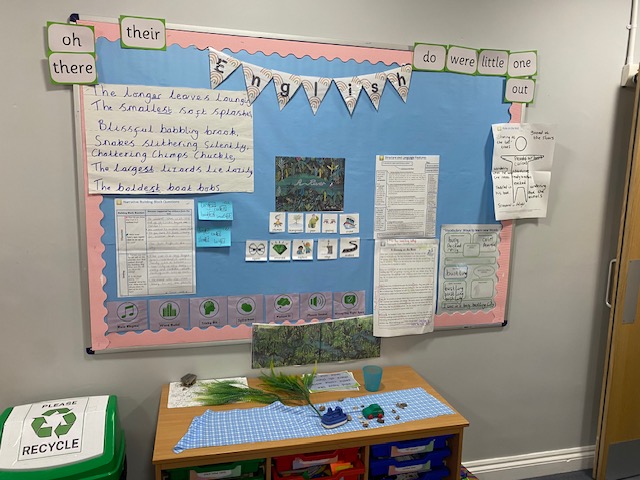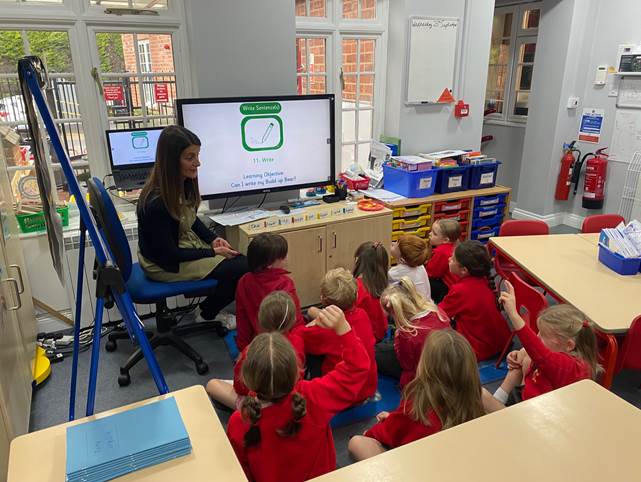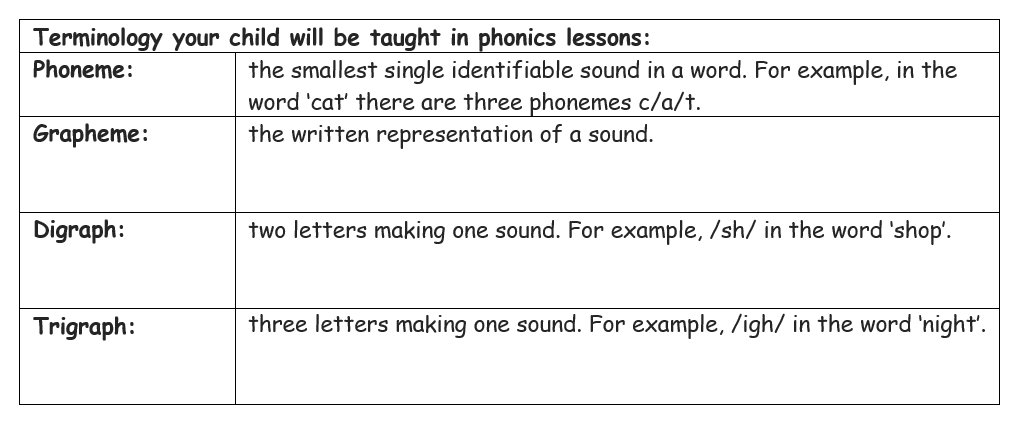English
Click to download: English National Curriculum | English Curriculum Statement
At Willoughby, we recognise that English is paramount since it unlocks doors to other areas of the curriculum; a wider range of vocabulary, other worlds and places; and helps children to develop empathy and understanding.


Phonics
As soon as they start school, EYFS children are taught phonics through a systematic synthetic phonics-based approach. The systematic synthetic phonics programme we use is Ready Steady Phonics and they continue with this programme throughout KS1 or until their phonics knowledge is secure.
Ready Steady Phonics, is a DfE Validated progressive systematic synthetic programme. It contains detailed guidance for effective implementation, and carefully crafted fully decodable texts that exactly match children’s growing phonic subject skills and knowledge.
How is phonics taught and how you can support your child.
- Your child will experience the same classroom routines within each lesson, which reduces cognitive load and maximises the chances of success.
- All children are supported within the lesson to use their new phonic knowledge independently.
Lots of opportunities are provided for oral blending – c/oa/t - Opportunities for writing – new graphemes, words and sentences are provided.
- Your child will bring home a phonics book which should be 90-95% decodable which we want them to practise at least four times across the week to build up fluency and expression.
- We only use pure sounds when decoding words (no ‘uh’ after the sound) Please watch these sound pronunciation videos for guidance.
If a child begins to fall behind in phonics, intervention will be timetabled in the form of Ready Steady Go sessions. These vital additional sessions ensure that every child’s potential is realised, in-line with the expectations.


Spellings
Years 5-6 tests
Ready Steady Spell
Ready Steady Spell year 2 | Ready Steady Spell year 3 | Ready Steady Spell year 4 | Ready Steady Spell year 5 | Ready Steady Spell year 6
Ready Steady Spell is a progressive systematic spelling programme from Year 2 up to Year 6, which we use at Willoughby.
It covers all National Curriculum expectations progressively for all these year groups. It provides full coverage, in a cyclical way, by providing opportunities to reinforce and embed learning systematically and interactively.
Ready Steady Spell contains detailed guidance for effective implementation and supports teaching through resources that allow children to acquire subject skills and knowledge and an understanding of spelling strategies needed for accurate recall. Furthermore, the beginning Year 2 spell lessons incorporate the Year 1 National Curriculum spelling rules and guidance that are not included in phonics teaching.
There are seven different strategies taught in the Ready Steady Spell programme:

Please refer to the following documents for further information on the seven strategies used and ways you can support your child at home.
Since Ready Steady Spell works by revisiting the learning objective, often three times. The first time the children meet the new spelling objective it is called an ‘Introduce’. The second time is called ‘Reinforce’ and the third time is ‘Embed’. This means that children have many opportunities to overlearn the spellings, the rules and the strategies and to embed these into their Long-Term Working Memory. These three ‘visits’ happen within and across year groups. When using this for mixed age planning this cycle of introduce, embed and revise can be useful as it means that many, if not, all of the objectives will be covered at least once, even within mixed year groups. Consequently, at Willoughby, year 3 and 4 children are taught spelling within a two-year rolling programme which is outlined in the able below.
However, due to SATS preparation and timetabling , year 2, 5 and 6 children are taught spelling as a year group.

Writing
For writing at Willoughby we use Ready Steady Write, which is comprehensive and evidence-based. It provides a sequenced, ambitious curriculum, that places quality literature at its core. Units have been carefully mapped out into rolling programmes to meet the needs of our mixed-aged teaching groups and ensure that the statutory curriculum for writing is covered. Where possible, connections have been made to marry up the texts to learning in other areas of the curriculum. leads to Impact and improved outcomes for children.
Ready Steady Write empowers teachers to provide high-quality teaching of writing through high-quality literature texts. Units of work centre on engaging, vocabulary-rich texts, with a wealth of writing opportunities within and across the curriculum and they also signpost wider curriculum enrichments and have fidelity by using:
Ready Steady Write follows the teaching sequence of immerse, analyse, plan and write. This is the same in EYFS, but worded slightly differently.

Reading
At Willoughby, we recognise that there are two elements to reading: recognising words and deciphering meaning from words. Additionally, we want to instil a love for reading for pleasure.
Decoding
At Willoughby, children begin their reading journeys through the systematic synthetic teaching of phonics to teach them to decode. On a daily basis, they read decodable words and texts and are also expected to read their decodable book at least four times at home to build up fluency. As well as their decodable book, the children also take home a book for pleasure that can be read to them at home.
Please see the following impact of reading to your child in the extract: Researchers in the United States who had looked at the impact of parents reading with their children quoted the following figures in a news release about their findings: Here’s how many words kids would have heard by the time they were 5 years old: Never read to, 4,662 words; 1–2 times per week, 63,570 words; 3–5 times per week, 169,520 words; daily, 296,660 words; and five books a day, 1,483,300 words. (DfE The Reading Framework July 2023). As children gain increased confidence with decoding texts, they do so with more independence.
Fluency
To develop rapid word recognition, it is essential that children spend time reading every day and ‘reading mileage’ is prioritised. This is achieved by children and adults taking turns to read aloud from the same text, with children following and keeping pace. Once children can accurately read 100+ words a minute, they are considered to be fluent readers. At this stage, children are ready to progress onto silent reading and responding to questions related to the text.
Vocabulary
Vocabulary development is supported in two ways – by teaching children particularly useful words and by revealing to them the etymological and morphological structure of the English language. Tier 2 vocabulary is discussed and taught through reading and writing lessons and tier 3 vocabulary is addressed through different areas of the curriculum.
Comprehension
Opportunities to practise retrieval, inference, explaining and predicting are provided during daily reading tasks and weekly comprehension activities in KS2. In KS2, children are introduced to a wide range of literature and non-fiction that they could not or might not choose to read independently consisting of extracts from a wide variety of high-quality texts. To promote fluency and expression, the teacher may model reading and expect the children to follow. Once the children are more fluent, children are expected to read more independently. Planned reading activities encourage pupils to think deeply and discuss a range of rich and challenging texts.
Children also have the opportunity to read for pleasure and are encouraged to read through a list of texts associated with their particular age. Additionally, reward systems are in place to encourage children to read a variety of genres, authors and text types. At Willoughby, we value the importance of children being read to and have timetabled sessions daily where the children are read to by their teachers.
Key Information
Head Teacher: Mrs Joanne Linnett
Co-Chairs of governors: Mrs Rebecca Kealy & Mr Nicholas Brown
Type of School: County Primary Co-Educational Day School for 4-11 years
Contact Details
Address: Willoughby Primary School, Church Lane, Willoughby on the Wolds, LE126SS
Useful Links
Willoughby Primary School on the Ofsted website & the Parent View
Willoughby Primary School on the Dept. For Education website
Admissions: Standard reception criteria from Nottinghamshire CC
